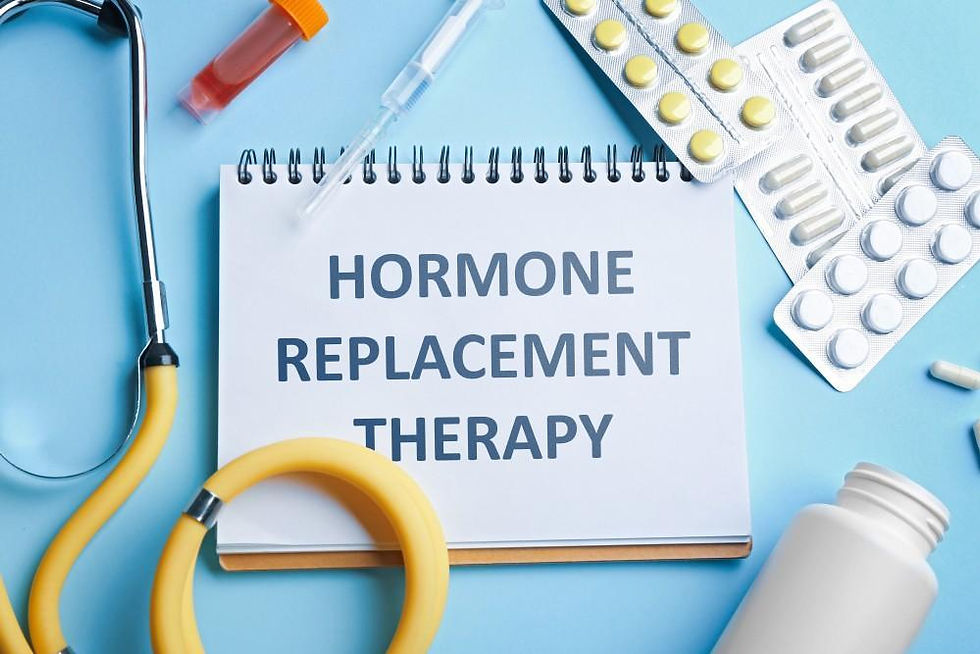HRT vs. Breast Cancer: Rethinking Testosterone for Women
- Rene Caruso

- Oct 10
- 3 min read

If men were misled for decades about testosterone safety, women arguably had it worse. After the Women’s Health Initiative (WHI) hit the headlines in 2002, hormone therapy was all but demonized. Millions of women were pulled off treatment overnight, and the fear has lingered for 20+ years.
Look closer, though, and the story changes.
How the WHI Fueled Fear—and What It Actually Showed
The WHI combined conjugated equine estrogen (CEE) with a synthetic progestin (medroxyprogesterone acetate, MPA) in women with a uterus; a separate arm used estrogen alone in women with prior hysterectomy. The increased breast-cancer signal came from the CEE+MPA arm. In contrast, estrogen-alone in hysterectomized women was associated with lower breast-cancer incidence, a finding reaffirmed in later analyses and meta-analyses. JAMA Network+2PubMed+2
Professional guidance has caught up: modern statements emphasize individualization (type, dose, route, timing) and acknowledge that short-term systemic therapy is reasonable for appropriate candidates; risk profiles differ for estrogen-only vs. estrogen+progestogen and by route. Lippincott Journals+1
Testosterone Is Also a Female Hormone
Every woman makes testosterone. Across a lifetime, women produce more testosterone than estrogen by volume. Physiologic testosterone supports energy, mood, libido, lean mass, and bone. Levels commonly fall in the late 30s–40s, which can track with fatigue, stubborn fat gain, sleep changes, and low desire.
What about breast safety?
A 2019 international consensus (endorsed by multiple societies) concluded that physiologic-dose transdermal testosterone for women does not increase mammographic density and, in short-term RCT data available, has not shown an increase in breast-cancer risk—but long-term randomized safety data are insufficient. Translation: short-term looks reassuring; true long-term causality (for prevention or risk) isn’t settled. OUP Academic
Large observational cohorts of women on long-term subcutaneous testosterone (often with an aromatase inhibitor) report lower observed breast-cancer incidence than age-matched reference populations (e.g., the 15-year “Dayton” updates and other series). These are hypothesis-generating—not randomized—so interpret with appropriate caution. Gavin Publishers+3ScienceDirect+3PMC+3
Bottom line: Short-term randomized data don’t show a breast-risk signal; observational cohorts even suggest lower incidence—but definitive long-term RCTs are still lacking. OUP Academic

“But I Was Told Any Hormone Feeds Cancer…”
That conclusion oversimplifies older oncology logic (think: androgen deprivation shrinks certain tumors, therefore hormones must “feed” them). Contemporary evidence is more nuanced:
For menopause therapy, estrogen alone reduced breast-cancer incidence in WHI randomized follow-up; combined estrogen–progestin increased it. Risk depends on the molecule and context, not on “hormones” as one monolith. JAMA Network+1
Reviews and professional positions today stress individualized therapy, shortest effective duration for symptoms, and shared decision-making rather than blanket prohibitions. Lippincott Journals
What About Survivors or High-Risk Women?
Small clinical series suggest testosterone (often with an aromatase inhibitor) can improve quality of life in symptomatic breast-cancer survivors without obvious short-term detriment—but these cohorts are small and non-randomized. Survivors should only consider any systemic hormone strategy in collaboration with their oncology team. PMC
For women at elevated baseline risk, established risk-reduction tools remain endocrine therapies (e.g., tamoxifen, aromatase inhibitors) per oncology guidelines—not testosterone. American Society of Breast Surgeons+1
Practical Takeaways (What I Tell Clients to Discuss With Their Clinician)
Separate myths from molecules.The WHI “risk” signal was tied to CEE+MPA. Estrogen alone in hysterectomized women reduced incidence in randomized data. Your risk discussion should name which hormone, which route, what dose, and why. JAMA Network+1
Testosterone for women is legitimate—but off-label in many countries.The 2019 Global Consensus supports physiologic-dose transdermal testosterone for women with HSDD, with short-term breast safety reassurance and insufficient long-term data. Dosing should aim for physiologic ranges, with monitoring for androgenic effects. OUP Academic
Observational cohorts are encouraging—not definitive.Reports of lower breast-cancer incidence with long-term testosterone therapy are compelling but not proof of causality. Use them to inform, not to over-promise. ScienceDirect+2PMC+2
Individualize and monitor.Align therapy to symptoms and risk profile; reassess regularly. This is the thrust of the NAMS 2022 position statement. Lippincott Journals
The Rebirth of HRT—With Nuance
A generation of women lost vitality because headlines outran the data. Today, better science and better guidance allow thoughtful use of hormone therapy—including physiologic testosterone—for symptom relief and function, while respecting individual risk.
The message isn’t “hormones for everyone.” It’s: get the molecule, dose, route, and timing right—and make decisions with your clinician based on you, not 20-year-old headlines.
Further Reading
Global Consensus Position Statement—Testosterone Therapy for Women (no short-term breast-risk signal; long-term data insufficient). OUP Academic
WHI & follow-ups: Estrogen alone reduced breast-cancer incidence; combined estrogen–progestin increased risk. JAMA Network+2PubMed+2
NAMS 2022 Position Statement: Individualized menopausal hormone therapy; benefits vs risks by regimen/route/timing. Lippincott Journals
Observational testosterone cohorts (Dayton & others): lower observed breast-cancer incidence vs reference populations (interpret with caution). Gavin Publishers+3ScienceDirect+3PMC+3
Disclaimer
I’m not a physician. This article reflects my interpretation of the literature for educational purposes and is not diagnosis, treatment, or medical advice. Always consult a qualified clinician before starting or changing therapy.







Comments